Summary:
A silent era documentary concerning medieval beliefs about witchcraft.
My Thoughts:
“Haxan” is a weird movie, but I freaking love it.
Christensen torturing his crew members.
Pazuzu- The demon from “The Exorcist”.
I first saw “Haxan” at a cinephile buddy’s house after he bought the DVD during a Barnes and Noble Criterion sale probably ten years ago. Before we watched it, I remember thinking: ‘Why am I going to a buddy’s house to watch a ninety-year-old silent film documentary on a fictional subject?’ But as soon as the film started up, I found myself wholly captivated. Though sitting through an hour and forty-five minute silent documentary might sound like a slog to get through, I found “Haxan” to be one of the most inventive documentaries I’ve ever seen (modern or classic). It had been a long while since I’d seen the film, so when Criterion announced the release of the Blu-Ray, I just knew I wanted to see it again, and I’m thrilled I did.
Now, before I go any further, I feel as if I need to clarify my 5/5 star rating for this film in particular. From a modern audience member’s perspective- that is, the kind of person that visits the theaters to see the latest Marvel movie and that’s about it- this film would probably be pretty boring. Remember that this is a silent documentary from 1922. I have a hard time convincing the average moviegoer to watch modern documentaries. I don’t expect modern audience to connect to this as much as I do, unless they have a previous interest in two things: witchcraft and early cinema.
“Haxan” is a 5/5 Star film because of the way it showcases the ideas that it talks about. The film uses miniatures to represent how medieval scholars thought the world was shaped; it uses reenactments to show how witches were said to have performed spells and consorted with demons; it implements pictures of woodcuttings that are hundreds of years old; Christensen even demonstrates torture devices which were used on witches on some of his crew members (seriously). Furthermore, this film lays the groundwork for many horror films that, today, are considered classics. There are scenes in this movie that are reminiscent of the opening of “The Witch”, where the titular character mashes a baby into paste in order to cast a spell which will make her fly. There are scenes that touch on the hysteria of the Loudun possessions, which are the subject of Ken Russell’s amazing and controversial film “The Devils”. We even see the statue of Pazuzu at one point, which was a Babylonian God/demon, and, coincidentally, the demon that possesses Regan MacNeil in “The Exorcist”. To say this film has an influence on films in the supernatural genre is a bit of an understatement.
But though this film is influential and interesting, it also has scenes that are undeniably thrilling and chilling, and the way in which Christensen structures the film kept me engaged to the end. Perhaps the most iconic and impressive scenes are those depicting the satanic masses that these so-called witches attend. Christensen uses fantastical sets and costumes that feel reminiscent of something we might see in the films of George Melies (“A Trip to the Moon”, “The Impossible Voyage”). The way in which Christensen brings us from one subject to the next is impressive. For instance, in the middle portion of the film, Christensen follows an accused witch as she undergoes her trial, and as we follow her, we learn how truly dire and hopeless the situation she’s in is for her. The film details how accused witches would be tied and tossed into deep water; if they floated, it was considered magic, and they were burned as a witch; if they sank, they were declared innocent, but they still drowned. If that’s not a loose-loose situation I don’t know what is.
Towards the end of the film, Christensen flashes forward to modern times, and uses this idea of a witch trial as a way illustrate the oppression of women in a patriarchal society. He further illustrates how woman were being oppressed even in the 1920s, but instead of the church doing the oppressing (the Church would lead the inquisitions), it is now the law. I felt that Christensen’s forward thinking really speaks to the brilliance of this film, and the themes in which he’s championing are truly ahead of the film’s time.
Verdict:
If you have an interest in silent films, early documentaries, or witchcraft, this movie is one you wont want to miss. If, however, you’re just looking to dip your toes into the world of silent film for the first time, I wouldn’t start here (try “Nosferatu” or “The Passion of Joan of Arc”). This movie is a marvel for cinephiles and those who have an interest in film history, but I have a hard time believing a Marvel fanboy would sit down and watch this from start to finish.
Review Written By:






